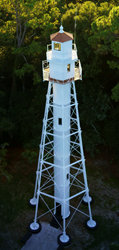Historic Hilton Head Rear Range Lighthouse in Palmetto Dunes Oceanfront Resort receives significant renovation
A source of storied legends, the lighthouse is part of the National Register of Historic Places and a popular Palmetto Dunes and Hilton Head Island visitor destination.
The Hilton Head Rear Range Lighthouse has undergone a significant renovation.
The distinctive structure, located in the Leamington neighborhood of Palmetto Dunes Oceanfront Resort overlooking the resort’s award-winning Arthur Hills Golf Course, was built between 1879 and 1880 as part of a larger system of navigation lights guiding ships into Port Royal Sound. Congress authorized $40,000 for the construction of the complex.
 A cast-iron skeleton tower built about a mile inland on six concrete piers, the lighthouse stands 94 feet tall and was activated on August 1, 1881. Light from the structure was visible from 15 miles away.
A cast-iron skeleton tower built about a mile inland on six concrete piers, the lighthouse stands 94 feet tall and was activated on August 1, 1881. Light from the structure was visible from 15 miles away.
Featured on the National Register of Historic Places and part of the Inventory of Historic Light Stations, the lighthouse occupies a unique place in Hilton Head Island history. One of only a handful of surviving lighthouses in South Carolina, the Hilton Head Rear Range Lighthouse is Hilton Head Island’s only historic lighthouse.
In 1985, Greenwood Communities and Resorts, the parent company of Palmetto Dunes, refurbished the lighthouse, cistern and oil house — installing a decorative sodium vapor optic —and opened the grounds to the public. On December 12, 1985, the Hilton Head Rear Range Lighthouse was added to the National Register of Historic Places, and has served as a popular Palmetto Dunes landmark and visitor destination ever since.
Now, the Hilton Head Rear Range Lighthouse has been renovated again, including the addition of a new cedar shingle roof, which was stained, replacement of 360-degree observation deck boards and structural wood areas, cleaning and treating of the interior, cleaning of the exterior, and the structure was painted with an oil-based, marine-grade paint. In addition, the windows and doors were replaced and painted in a “Charleston Green,” while overgrown foliage around the lighthouse was removed, and more.
“We are pleased with the recent renovation and improvements to this historic Hilton Head Rear Range lighthouse and excited to welcome visitors to see the completed project,” said Palmetto Dunes Vice President of Resort Operations Brad Marra. “We’re also excited to share the recent tree survey information on one of the oldest oak trees on Hilton Head Island that is adjacent to the lighthouse.”
The Leamington Lighthouse Live Oak (Quercus virginiana) stands close to the Hilton Head Rear Range Lighthouse and provides a magnificent backdrop for the 15th green of the Arthur Hills Golf Course. The tree stands approximately 70 feet tall and has a canopy that spreads across 150 feet. With a diameter of about 9 feet, calculations estimate the age of the tree to be between 435 to 450 years old (survey report 2019), recognizing it as one of Hilton Head Island’s oldest living trees.
Guests who wish to visit the lighthouse should enter Palmetto Dunes and proceed to the resort’s South Gate, where they can request a guest pass. Proceed to the Leamington Gate and turn left onto Leamington Lane to the lighthouse, then park along the roadside. Unfortunately, the lighthouse is not open for visitors to view inside or to climb to the top.
The Lighthouse area is also one of numerous popular wedding venues in Palmetto Dunes, and is available for small private events.
The original lighthouse complex included a keeper’s house and a shorter forward beacon that was mounted on a second keeper’s house near the beach. By positioning their ships so that the two beacons were vertically aligned, sailors entering Port Royal Sound would know that their vessels were in the proper channel.
Today, only the rear lighthouse survives, along with a vintage brick oil house and a water cistern located on site alongside the oldest living oak tree on Hilton Head Island. Sheltered by towering pine trees, the main lighthouse structure, which is now inactive, includes a central cylindrical stair tower, a wooden watch room and a cypress lantern room. Lighthouse Keepers would climb 112 steps to reach the hexagonal watch room.
A number of interesting ghost stories and legends surround this historic lighthouse. In 1898, a major hurricane lashed the South Carolina coast. Determined to keep the light burning, lighthouse keeper Adam Fripp died of a heart attack during the storm. At Fripp’s urging, his 21-year-old daughter, Caroline, kept the navigational light burning. But she passed away just three weeks later from exhaustion and the loss of her father, inspiring haunted sightings of a female ghost in a long blue dress on dark, rainy nights.
The lighthouse, which originally included a wooden exterior, was deactivated in 1932. During World War II, however, the structure served as an important lookout tower for enemy ships and anchored Camp McDougal, a network of U.S. Marine temporary barracks and ammunition sheds. Gun emplacements and searchlights were established on the nearby beach. Marines were taught to use naval guns, called “Big Betsy,” as well as .30 and .50 caliber machine guns, and practiced firing these weapons into the Atlantic.
For historical photos and documents, an extensive history and information on visiting the Hilton Head’s Rear Range Lighthouse in Palmetto Dunes, visit http://www.hiltonheadlighthouse.com. And join us on Facebook at https://www.facebook.com/thehiltonheadlighthouse.



